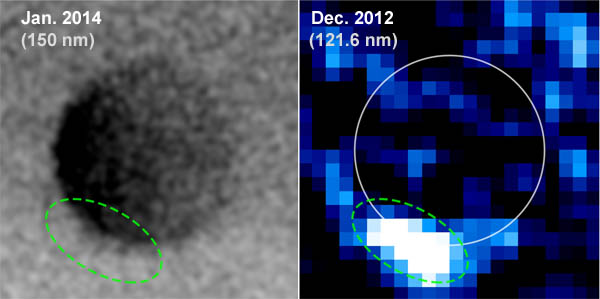Astronomy - Hints of Geysers Erupting from Europa
Newly released Hubble images show what appear to be towering jets of water coming from Jupiter's moon Europa.
In 1979, images from Voyagers 1 and 2 showed Jupiter's moon Europa to have a cracked but billiard-ball-smooth surface. Planetary geophysicists concluded that this icy world must have a deeply buried ocean, one that episodically floods the surface.

A Galileo orbiter image of Europa has been added to a just-released Hubble Space Telescope image of what might be towering geysers of water erupting from near the moon's south pole.
NASA / ESA / W. Sparks / USGS Astrogeology Science Center
NASA / ESA / W. Sparks / USGS Astrogeology Science Center
That's when astrobiologists started talked earnestly about the possibility that Europa's ocean might conceivably host primitive life of some sort. But the putative ocean's depth below the ice crust is unknown, though it must be at least several kilometers thick — a formidable barrier to exploring it with submersible, life-seeking probes.
It turns out that sampling Europa's ocean might be easier than once thought. New results from the Hubble Space Telescope, announced this week, show what appear to be towering plumes of water jetting away from Europa's surface.

These panels identify possible plumes of water erupting episodically along Europa's southern limb. At left, in a far-ultraviolet Hubble image, is a dusky smudge seen in silhouette against Jupiter's bright disk in the background. At right, a previous Hubble image reveals emission from hydrogen atoms emitting at the Lyman alpha wavelength in ultraviolet light.
NASA / ESA / W. Sparks (left) / L. Roth (right)
NASA / ESA / W. Sparks (left) / L. Roth (right)
Hints that Europa might have water-powered geysers first came to light in 2012, when a team led by Lorenz Roth (Southwest Research Institute) used HST to spectroscopically detect localized clouds of hydrogen and oxygen atoms in Europa's vicinity. It was tantalizing but not conclusive evidence.
The new results, though again not offering rock-solid proof, use an entirely different technique to suggest that Europa might be belching water into space. William Sparks (Space Telescope Science Institute) and others have used Hubble to record images of Europa as it crossed in front of Jupiter. They wanted to see if the moon has a thin atmosphere, which would show up as a dark aura around Europa when viewed in silhouette against Jupiter. (Other observers are trying to exploit this same transit technique to detect atmospheres around the planets of distant stars.)
Sparks' team tracked 10 transits of Europa from December 2013 to March 2015, along with seven other sessions to model the appearance of Europa itself. They used a far-ultraviolet channel (centered at 150 nanometers) on HST's Space Telescope Imaging Spectrograph, because that wavelength is scattered by Jupiter's high-altitude hazes and its disk looks featureless. Moreover, Hubble's resolution is best at ultraviolet wavelengths; with Jupiter 4 astronomical units away, this yields details as small as 38 km across.
As seen in the sequence below, Sparks and his team noticed what could be plumes on three occasions. Two of the presumed eruptions appear to come from the moon's south polar region — the same general locale implicated by Roth's team — and the third was nearer the equator. The vague puffs seem to extend at least 200 km (125 miles) above Europa's limb. Details appear in September 29th's Astrophysical Journal.

These three panels show (in false color) what appear to be plumes of water extending from the limb of Europa. At this far-ultraviolet wavelength (centered at 150 nm), Europa actually looks dark, so an image of the moon from the Galileo spacecraft has been added. Jupiter's dark and featureless disk is in the background.
NASA / ESA / W. Sparks / USGS Astrogeology Science Center
NASA / ESA / W. Sparks / USGS Astrogeology Science Center
The researchers are hopeful but cautious about their results. In one image, for example, the base of a possible plume doesn't coincide with the limb of Europa itself, as it should. And the full extent of the puffs cover roughly the same area as Europa itself, which on one hand might yield clues to the power of the eruptions — but also might imply that they're unanticipated imaging artifacts. "We are really working at the limits of Hubble's unique capabilities," Sparks says.
The forthcoming James Webb Space Telescope should eventually be able to reveal what's really going on. Still, the prospect of Europa episodically spouting samples of its hidden ocean directly into space has interplanetary planners salivating. Future spacecraft might be able to assess the ocean's composition and life-hosting qualities merely by landing on the surface near an eruptive vent or flying through one of the plumes at close range.
Learn more about the new results — and judge the imaging evidence for yourself — at the STScI's announcement page.
One more thing: Thoughts about life on Europa preceded the Voyager flybys. In Arthur C. Clarke's 2001: A Space Odyssey, released in 1968, this moon was the origin of the mysterious black obelisk and the destination of the crew aboard the spaceship Discovery. But the reasons Clarke and director Stanley Kubrick chose Europa were more pragmatic than prescient.
No comments:
Post a Comment